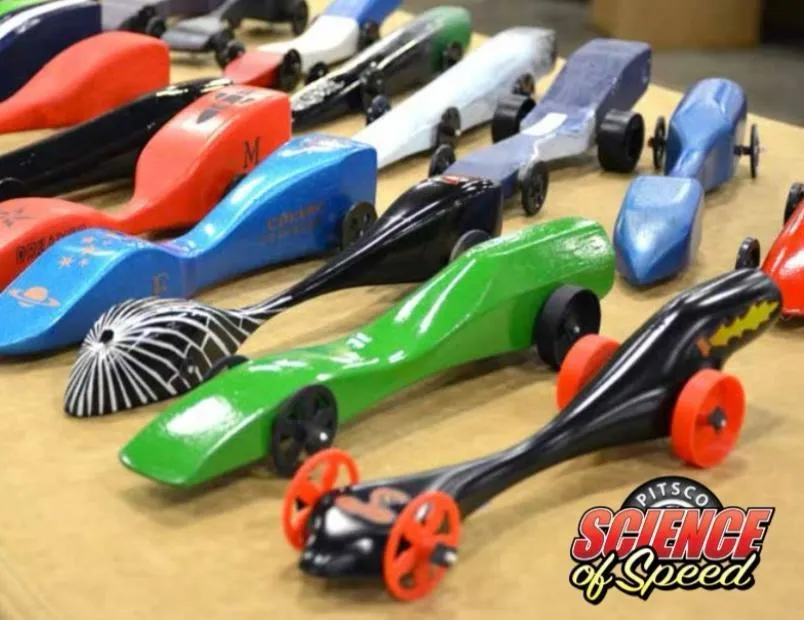

CO2 Race Car Building, Basic Woodworking



CO2 Race Car Building
- Basic Woodworking -
This class is taught by Eric Firman
In this course, students will build a CO2 race car out of wood while learning the proper use of tools and safety equipment.
As part of the STEM program, students will learn how efficient design affect the vehicle’s performance.
During this course, we will build the cars from a kit I provide using a drill, hacksaw, sandpaper, and wood file. I will also have the kids paint and decorate them. At the end of the semester, we will have a car race.
Using a race track the students will compete to reveal who created the most effective design. The winner will take home a trophy!
Throughout the semester we will discuss tips on how to make the car lighter, more aerodynamic, and how the forces of nature affect speed.
The goal is to allow students to apply concepts from physics with real-world application.
TOPICS
16-Week Model Car Building and Racing Course Outline**
Course Overview
This 16-week course will guide students through the process of building and racing a model car while integrating STEM (Science, Technology, Engineering, and Mathematics) principles. The course is designed for middle to high school students with an interest in hands-on learning and engineering. Each week focuses on a specific aspect of the project, gradually building up to the final race.
*Week 1: Introduction to the Course and STEM Principles
- Objective: Understand the course structure, objectives, and the importance of STEM in everyday life.
- Activities:
- Course overview and expectations.
- Introduction to STEM principles (focus on physics, engineering, and mathematics).
- Discussion on real-world applications of STEM in automotive engineering.
*Week 2: Basics of Model Car Design
- Objective: Learn the fundamental concepts of car design, including aerodynamics and weight distribution.
- Activities:
- Introduction to basic car design principles.
- Exploration of how aerodynamics affect speed and performance.
- Sketching initial design ideas for the model car.
*Week 3: Introduction to Physics of Motion
- Objective: Understand the basic physics of motion, including Newton's laws, friction, and gravity.
- Activities:
- Classroom demonstrations on Newton’s laws of motion.
- Discussions on how friction and gravity impact car movement.
- Application of physics principles to model car design.
*Week 4: Materials Science and Selection
- Objective: Learn about different materials and their properties, focusing on what’s best for building a model car.
- Activities:
- Introduction to materials science.
- Exploring the properties of various materials (e.g., plastic, wood, metal).
- Selecting materials for different parts of the model car.
*Week 5: Introduction to Electrical Engineering (Optional)
- Objective: Understand the basics of electrical engineering, focusing on battery-powered cars.
- Activities:
- Introduction to electrical circuits and power sources.
- Building a simple circuit to power a small motor.
- Discussion on energy sources and efficiency in model cars.
*Week 6: Building the Chassis
- Objective: Start the hands-on construction of the model car, focusing on the chassis.
- Activities:
- Introduction to the importance of a sturdy chassis.
- Hands-on workshop: Building the chassis based on design sketches.
- Testing the chassis for strength and stability.
*Week 7: Designing and Building the Wheels and Axles
- Objective: Learn about wheel and axle mechanics and build these components.
- Activities:
- Introduction to the mechanics of wheels and axles.
- Workshop: Designing and constructing the wheels and axles.
- Testing for smooth rotation and alignment.
*Week 8: Aerodynamics and Body Design
- Objective: Apply aerodynamic principles to design and build the body of the car.
- Activities:
- Exploration of how shape affects airflow and speed.
- Designing the body of the car for optimal aerodynamics.
- Building and attaching the body to the chassis.
*Week 9: Introduction to Gearing and Speed
- Objective: Understand how gears affect speed and torque in model cars.
- Activities:
- Introduction to gear ratios and their impact on performance.
- Hands-on activity: Experimenting with different gear combinations.
- Application of optimal gearing to the model car.
* Week 10: Power Systems and Energy Efficiency
- Objective: Learn about power systems and how to maximize energy efficiency.
- Activities:
- Discussion on different power systems (e.g., wind, solar, electric).
- Calculating energy efficiency for different power sources.
- Integrating the chosen power system into the model car.
*Week 11: Testing and Troubleshooting
- Objective: Test the model car and troubleshoot any issues.
- Activities:
- Initial test run of the model car.
- Identifying and fixing problems (alignment, power, aerodynamics).
- Documenting changes and improvements.
*Week 12: Data Collection and Analysis
- Objective: Collect and analyze data from test runs to improve performance.
- Activities:
- Collecting data on speed, distance, and energy usage.
- Analyzing the data to identify areas for improvement.
- Applying mathematical principles to optimize performance.
*Week 13: Final Adjustments and Enhancements
- Objective: Make final adjustments to the model car based on data analysis.
- Activities:
- Implementing changes from the data analysis.
- Enhancing design for final performance (e.g., weight reduction, aerodynamics).
- Final test runs and performance evaluation.
*Week 14: Preparation for the Race
- Objective: Prepare the model car and students for the final race.
- Activities:
- Review race rules and criteria for winning.
- Practicing race day procedures (starting, navigating the course).
- Final checks and preparations.
*Week 15: Race Day
- Objective: Compete in the model car race and apply learned STEM principles.
- Activities:
- Race setup and car inspections.
- Running the races in various heats.
- Recording race results and determining winners.
*Week 16: Reflection and Presentation
- Objective: Reflect on the course and present findings and experiences.
- Activities:
- Student presentations on their design, challenges, and learning outcomes.
- Reflection on the integration of STEM principles in the project.
- Award ceremony and course wrap-up.
***Materials Needed:
- Model car kits or individual parts (chassis, wheels, axles, motors, etc.)
- Basic tools (screwdrivers, pliers, glue, etc.)
- Measurement tools (rulers, scales, protractors)
- Data recording tools (stopwatches, notepads, or digital devices)
- Power sources (batteries, solar cells, etc.)
***Assessment Criteria:
- Participation and Engagement: Regular attendance and active involvement in activities.
- Design and Construction: Quality and creativity of the model car design.
- Application of STEM Principles: Demonstrated understanding of STEM concepts.
- Performance in Race: Speed, stability, and overall race performance.
- Final Presentation: Clarity, depth, and reflection on the learning experience.
This course provides a comprehensive experience in both the theory and practice of model car building, giving students hands-on experience with engineering and problem-solving.
PRP Injections
PRP (Platelet-Rich Plasma) injections are a cutting-edge treatment that uses your body's own platelets to promote healing and rejuvenation. During the procedure, a small amount of your blood is drawn and processed to concentrate the platelets. This platelet-rich plasma is then injected into the targeted areas, stimulating collagen production and tissue regeneration. PRP injections are commonly used for improving skin texture and tone, reducing wrinkles, and treating hair loss. This natural and minimally invasive treatment harnesses your body’s healing powers for effective and long-lasting results.
$700 • 1 hr
Payment:$325/16 week course + $50 material fee per course.
This course can be taken all year long (both fall and spring,16 week courses) and can be paid in full with charter funds or cash payments over 4 months at $81.25 per month due by the 1st of each month.
We are approved with PCA.

What other educators are saying . . .

I had the pleasure of having her as one of the instructors in Drafting and Design department at ITT Technical Institute while I was a school chair. I was immediately impressed with her extensive knowledge in Revit which was the subject I needed an instructor for. Not only her skill was exceptional, her commitment for the job exceeded an expectation. I would recommend her with not hesitation.

Niko Sasso
ITT SUPERVISOR
There are those that sell stuff to make a living.
Then there are those that from their own research and experience solving problems for themselves have created a community by 'serving' others.
The latter is true for Eric and Fernanda at Suliss Water & Air."

John Biethan
President and Producer at Imagine Podcasting
FREQUENTLY ASKED QUESTIONS

What should I expect during my first visit?
Your first visit begins with a comprehensive consultation where our experts will assess your skin and discuss your aesthetic goals. We will recommend personalized treatment options and answer any questions you may have to ensure you feel comfortable and informed.
Are your treatments safe?
Yes, all our treatments are performed by highly trained and certified professionals using state-of-the-art equipment and techniques. We prioritize your safety and comfort, adhering to the highest standards of medical care and hygiene.
How do I know which treatment is right for me?
Our team will guide you through the selection process during your initial consultation. We’ll evaluate your skin type, concerns, and goals to recommend the most suitable treatments to achieve the best results for you.
Is there any downtime after treatments?
Most of our treatments are non-invasive or minimally invasive, requiring little to no downtime. However, the recovery time can vary depending on the specific treatment. During your consultation, we will provide detailed post-treatment care instructions and inform you about any necessary recovery time.
How often should I schedule treatments?
The frequency of treatments depends on the type of service and your individual needs. Some treatments, like facials, may be done monthly, while others, like laser hair removal, may require a series of sessions spaced several weeks apart. We will create a personalized treatment plan to ensure optimal results.
Do you offer packages or memberships?
Yes, we offer a variety of packages and memberships designed to provide you with ongoing care and savings. Our packages bundle popular treatments for comprehensive care, while our memberships offer exclusive benefits and discounts. Contact us to learn more about our current offerings and find the perfect plan for your needs.

© 2025 All Rights Reserved. Terms of Use and Privacy Policy.
Website built by www.fernandafirman.com